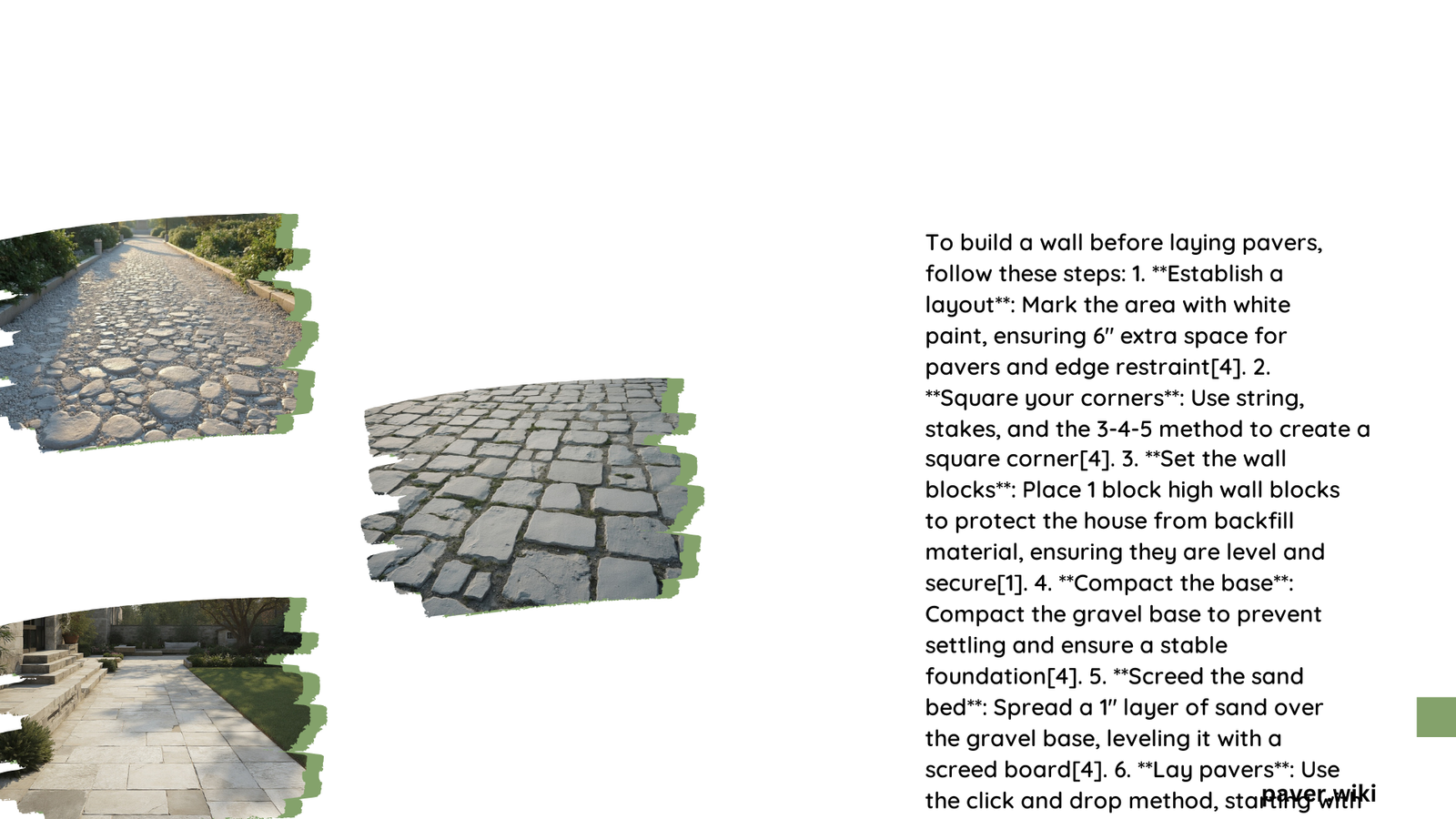Building a retaining wall before laying pavers is crucial for creating a stable and long-lasting outdoor space. This process involves careful planning, proper materials selection, and precise execution. By constructing the wall first, you ensure a solid foundation for your paver project, prevent soil erosion, and create a visually appealing landscape feature. This guide will walk you through the essential steps and considerations for making a wall before laying pavers.
Why Should You Make the Wall Before Laying Pavers?
Creating a retaining wall before installing pavers is essential for several reasons:
- Soil stabilization
- Proper drainage
- Level surface creation
- Enhanced aesthetics
- Increased property value
By addressing these factors, you set the stage for a successful paver installation that will stand the test of time.
What Materials Do You Need for Wall Construction?

Before starting your wall project, gather the following materials:
- Retaining wall blocks or stones
- Landscape fabric
- Paver base (crushed stone)
- 3/4″ rough gravel for drainage
- Leveling sand
- Construction adhesive
- Geogrid (for reinforced walls)
- Perforated drainage pipes
Having these materials on hand ensures a smooth construction process and helps avoid delays.
How Do You Plan the Wall’s Dimensions?
Proper planning is crucial for a successful retaining wall. Consider the following guidelines:
- Wall Height: Determine the desired height based on your landscape needs.
- Wall Width: The base width should be at least half the wall’s height. For example, a 5-foot tall wall requires a minimum 2.5-foot wide base.
- Length: Measure the area where the wall will be installed to determine the required length.
| Wall Height | Minimum Base Width |
|---|---|
| 3 feet | 1.5 feet |
| 4 feet | 2 feet |
| 5 feet | 2.5 feet |
| 6 feet | 3 feet |
What Are the Steps to Build the Retaining Wall?
Follow these steps to construct your retaining wall:
- Site Preparation and Excavation
- Dig a level-bottomed trench
- Ensure it’s wide enough for base stones
-
Aim for a depth of about 12 inches
-
Base Material Installation
- Lay a 6-inch layer of packed gravel
- Compact in 2-inch layers using a plate compactor
-
For walls over 18 inches, use a 6-inch base
-
Landscape Fabric Placement
- Cover the trench with landscape fabric
- Secure it with base stones
-
Ensure a level and stable foundation
-
Wall Construction
- Start the second layer using a staggered pattern
- Apply adhesive between layers
-
Lean the wall back 2 inches per foot of height
-
Drainage and Backfill
- Fill hollow cores with compactible aggregate
- Add at least 12 inches of backfill behind the wall
- Install perforated drainage pipes at the base
How Do You Ensure Proper Drainage?
Proper drainage is critical for the longevity of your retaining wall and paver installation. Consider these drainage elements:
- Install perforated drainage pipes along the entire wall base
- Connect vertical pipes to the horizontal drainage pipe every 20-30 feet
- Use 3/4″ rough gravel for drainage behind the wall
- Grade the surrounding soil to direct water away from the wall
What Are the Key Considerations for Paver Installation?
Once your retaining wall is complete, you can proceed with paver installation:
- Prepare the Area
- Mark the paver location with stakes and string
-
Ensure the area is level and debris-free
-
Lay Gravel Base
- Spread a 2-3 inch layer of compacted gravel
-
Use a plate compactor for proper compaction
-
Add Sand Bed
- Spread a 1-inch layer of leveling sand
-
Ensure even distribution
-
Place Pavers
- Start from one corner and work outward
- Use a level to ensure proper placement
-
Leave 1/8 inch gaps between pavers
-
Fill Joints
- Sweep sand into gaps between pavers
- Compact sand using a plate compactor
- Repeat until joints are fully filled
What Are the Estimated Timeframes for Wall and Paver Installation?
Understanding the time investment helps in project planning:
- Retaining Wall Construction: 3-5 days
- Base Preparation for Pavers: 1-2 days
- Paver Placement: 1-3 days
- Joint Filling: 1 day
Total estimated time: 6-11 days, depending on project size and complexity.
How Do You Calculate Material Quantities and Costs?
Accurate material estimation is crucial for budgeting:
- Retaining Wall Blocks: Calculate cubic footage and divide by 15 for tons needed
- Gravel and Sand: 0.4 cubic feet of crushed stone and 0.35 cubic feet of gravel backfill per square foot of wall face
- Add 10-20% extra for cutting waste and compaction
Example calculation for a 10′ x 3′ x 2′ wall:
– Stone needed: (10 x 3 x 2) / 15 = 4 tons
– Crushed stone: 10 x 3 x 0.4 = 12 cubic feet
– Gravel backfill: 10 x 3 x 0.35 = 10.5 cubic feet
What Are Potential Challenges and Solutions?
Be prepared to address these common issues:
- Soil Instability
-
Solution: Replace unstable soil with compacted granular base material
-
Water Pooling
-
Solution: Proper grading and effective drainage system implementation
-
Uneven Settlement
- Solution: Thorough base preparation and compaction
By anticipating these challenges, you can ensure a smoother construction process and a more durable final product.
In conclusion, making the wall before laying pavers is a crucial step in creating a stable and attractive outdoor space. By following this comprehensive guide, you’ll be well-equipped to tackle your retaining wall and paver project with confidence.
References:
1. Landscape Management – Step by Step: How to build a retaining wall
2. Handyman Startup – How To Build a Retaining Wall (Step By Step Guide)
3. Allan Block – Reinforced Retaining Wall Construction
